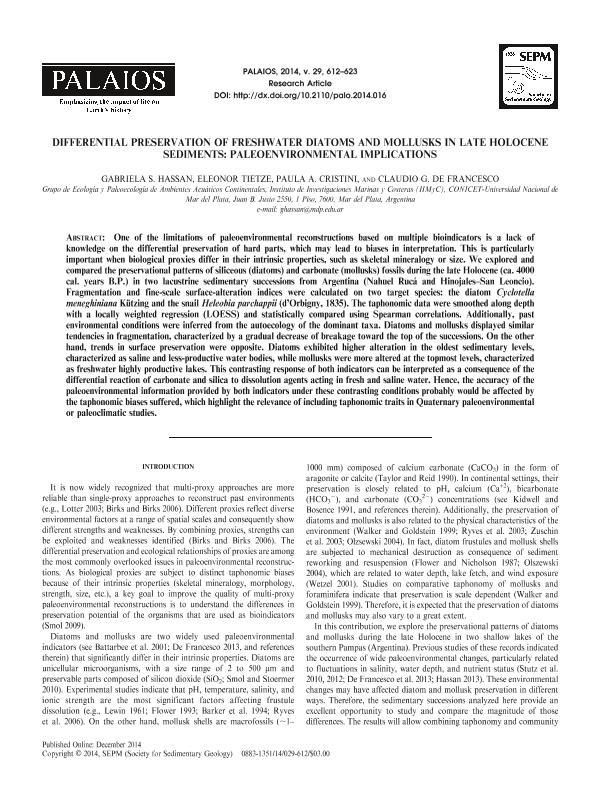Artículo
Differential preservation of freshwater diatoms and mollusks in late Holocene sediments: paleoenvironmental implications
Fecha de publicación:
10/2014
Editorial:
Society for Sedimentary Geology
Revista:
Palaios
ISSN:
0883-1351
Idioma:
Inglés
Tipo de recurso:
Artículo publicado
Clasificación temática:
Resumen
One of the limitations of paleoenvironmental reconstructions based on multiple bioindicators is a lack of knowledge on the differential preservation of hard parts, which may lead to biases in interpretation. This is particularly important when biological proxies differ in their intrinsic properties, such as skeletal mineralogy or size. We explored and compared the preservational patterns of siliceous (diatoms) and carbonate (mollusks) fossils during the late Holocene (ca. 4000 cal. years B.P.) in two lacustrine sedimentary successions from Argentina (Nahuel Rucá and Hinojales–San Leoncio). Fragmentation and fine-scale surface-alteration indices were calculated on two target species: the diatom Cyclotella meneghiniana Kützing and the snail Heleobia parchappii (d'Orbigny, 1835). The taphonomic data were smoothed along depth with a locally weighted regression (LOESS) and statistically compared using Spearman correlations. Additionally, past environmental conditions were inferred from the autoecology of the dominant taxa. Diatoms and mollusks displayed similar tendencies in fragmentation, characterized by a gradual decrease of breakage toward the top of the successions. On the other hand, trends in surface preservation were opposite. Diatoms exhibited higher alteration in the oldest sedimentary levels, characterized as saline and less-productive water bodies, while mollusks were more altered at the topmost levels, characterized as freshwater highly productive lakes. This contrasting response of both indicators can be interpreted as a consequence of the differential reaction of carbonate and silica to dissolution agents acting in fresh and saline water. Hence, the accuracy of the paleoenvironmental information provided by both indicators under these contrasting conditions probably would be affected by the taphonomic biases suffered, which highlight the relevance of including taphonomic traits in Quaternary paleoenvironmental or paleoclimatic studies.
Palabras clave:
Comparative Taphonomy
,
Shallow Lakes
,
Quaternary
,
Dissolution
Archivos asociados
Licencia
Identificadores
Colecciones
Articulos(IIMYC)
Articulos de INSTITUTO DE INVESTIGACIONES MARINAS Y COSTERAS
Articulos de INSTITUTO DE INVESTIGACIONES MARINAS Y COSTERAS
Citación
Hassan, Gabriela Susana; Tietze, Eleonor; Cristini, Paula Andrea; de Francesco, Claudio German; Differential preservation of freshwater diatoms and mollusks in late Holocene sediments: paleoenvironmental implications; Society for Sedimentary Geology; Palaios; 29; 12; 10-2014; 612-623
Compartir
Altmétricas




